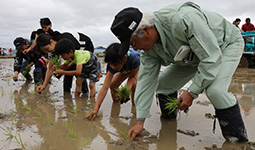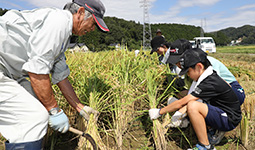Home > Highlighting JAPAN > Highlighting Japan November 2019 > Japan’s Food Culture
Highlighting JAPAN


The Rice That Nurtures Storks
In Toyooka City, Hyogo Prefecture, the return to wet-paddy cultivation of rice and other environment-friendly farming initiatives has not only revived the local stork population but also produced a brand of rice with outstanding stickiness and sweetness.
The stork is a migratory bird that breeds in southeastern Siberia and flies south in the winter. It could once be seen in many parts of the country in the winter. Some clusters of storks occasionally stay in a Japanese wintering location, and the Tajima region including Toyooka City in northern Hyogo Prefecture used to be a typical habitat. But the Japanese inhabitable environment for storks worsened in the twentieth century, and in 1971 wild storks became extinct in Tajima, which was their last domestic habitat.
Subsequently, with the aim of bringing storks back into the wild, Toyooka City bred storks provided to the prefecture by Khabarovsk in the former Soviet Union, the sister city of Hyogo Prefecture, and succeeded in breeding them for the first time in 1989. The city began releasing storks into the wild in 2005, and more than 150 field populations exist as of 2019.
The attempt to bring storks back into the wild, which was considered very difficult, was successful in large part due to the constant cooperation of the rice farmers in Tajima. The causes of the storks becoming extinct were a major change in the environment of the rice paddies, a feeding ground, as well as indiscriminate hunting and the cutting down of large numbers of nesting pine trees. In the past, there were many wet rice paddies in Japan, whose soil was always wet. After World War II, however, dry rice paddies became predominant because they made it easier to introduce agricultural machinery and led to a better harvest. However, because dry rice paddies have dry ground except during the rice cultivation season, aquatic creatures such as the frogs and small fishes that storks feed on cannot inhabit them. In addition, the growing use of agricultural chemicals and chemical fertilizers, even in the rice cultivation season, caused almost all the aquatic creatures to disappear.
To create an inhabitable environment for storks, five volunteer farmers launched a farming method that nurtures storks in Toyooka City in 2003. This farming method is characterized by not using agricultural chemicals or by reducing them as much as possible to create an environment that is easy for aquatic creatures to inhabit, and by putting water into rice paddies even in winter after rice cultivation is over.
Ohara Hiroyuki, Chairman of Tajima Agricultural Cooperative (JA Tajima) Committee for Producing Stork Natural Rice, says, “Most farmers had only experienced the cultivation of rice in dry rice paddies. It was truly starting from scratch to create an inhabitable rice paddy environment for storks and realize tasty rice at the same time.”
But as the farmers went ahead with the farming method that nurtures storks, more aquatic creatures appeared in the rice paddies, and the growth environment for storks returned. JA Tajima named the rice cultivated in this way “Stork Natural Rice” and began selling it. Currently, about 300 farmers in the city cultivate this rice, producing more than 1,500 tons annually.
Stork Natural Rice is so tasty, with outstanding stickiness and sweetness, that it is not only purchased by consumers nationwide but is also exported overseas. JA Tajima invites consumers to events, such as a field trip to rice paddies and a rice-reaping experience program, in an effort to deepen the exchanges between consumers and producers.
“Traditionally, people in Tajima eat a local dish called barazushi, which is a mixture of ingredients, such as fish and vegetables, scattered on sushi rice, meaning that they consume a lot of rice. Stork Natural Rice takes so much time and effort to produce in terms of water management and weeding that its price is relatively high. But we do not want to make the rice special. We hope that it will be rice that local people will enjoy eating every day,” says Ohara. In response to this producer’s wish, Toyooka City uses Stork Natural Rice for lunches at elementary schools in the city.
As the farmers proceeded with the farming method that nurtures storks, ecosystems full of biodiversity returned to Tajima. In this region, farmers using the standard cultivation method also began working on environment-friendly cultivation. In addition, by collaborating with the stockbreeders of Tajima beef, a local specialty, the local rice farmers provide them with the rice straw that remains after harvesting Stork Natural Rice and are given manure from the cattle in exchange. As this shows, an agricultural cycle is being created throughout the Tajima region.
Producers and consumers are joining hands through rice cultivation that nurtures storks and will make continued efforts to pass down a rich food culture to the next generation.
© 2009 Cabinet Office, Government of Japan








